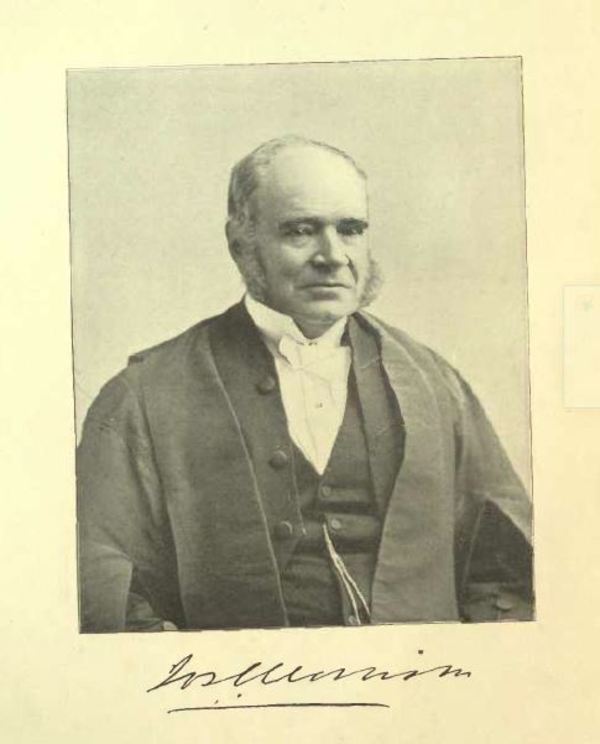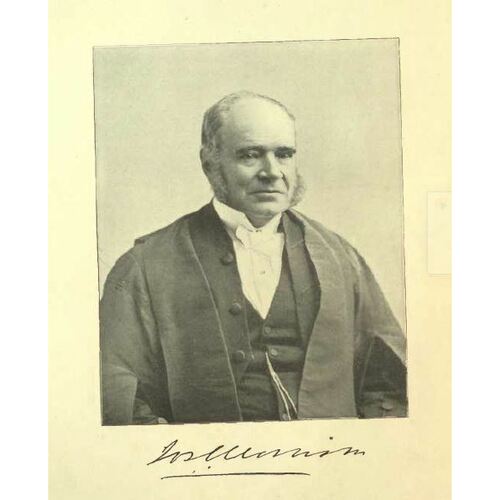
Source: Link
MORRISON, JOSEPH CURRAN, lawyer, politician, and judge; b. 20 Aug. 1816 in Ireland, eldest son of Hugh Morrison and his first wife, Mary Curran, and elder brother of Angus Morrison; m. 23 July 1845 Elizabeth Bloor, and they had three sons and three daughters; d. 6 Dec. 1885 in Toronto, Ont.
The family background and early life of Joseph Curran Morrison remain obscure. Accounts of Morrison given by his contemporaries make passing references to his father’s Scottish origins and his mother’s supposed family connections. It is certain, however, that Morrison attended the Royal Belfast Academical Institution in 1826; in 1830 his family immigrated to Upper Canada. In 1831 his father became an innkeeper at York (Toronto) and Joseph was attending Upper Canada College. Hugh Morrison died in August 1834 and Joseph Curran became involved in a dispute with his father’s second wife, Frances (Fanny), sister of John Montgomery*, over the division of the estate. As a result, the children of Mary Curran left their stepmother, and Joseph, at 18, became the head of a household consisting of four younger brothers and sisters. In 1834 he enrolled as a law student and entered the office of Simon Ebenezer Washburn*. One of his younger brothers, Angus, was to follow him into law and politics.
After Joseph’s admission to the bar in 1839, he formed a partnership with another of Washburn’s pupils, William Hume Blake*; in 1842 George Skeffington Connor* joined the firm. Morrison, who attended mainly to its commercial clients, prospered as a lawyer and he shared an interest in Reform politics with his partners. In 1841 he acted as campaign secretary for Isaac Buchanan. Two years later he was appointed clerk of the Executive Council and he served it for four years in its capacity as a Court of Appeal. During the 1840s Morrison established connections with several other Reformers: in 1844 he pledged funds to aid George Brown* in founding the Globe and he shared with Francis Hincks an interest in establishing a public school system. Morrison was appointed to the Board of Education (which became the Council of Public Instruction in 1850) when it first met in 1843 and continued as a member for 30 years. Egerton Ryerson noted in 1857 that Morrison, after he had gained elective office, “devoted more time than any other political man in Canada” to serving as mediator or “connecting link” between Ryerson and the council on the one hand and the legislature on the other.
Morrison’s political career had begun in 1848 when he successfully contested the riding of York West. As a member of the assembly he supported the Reform administration of Louis-Hippolyte La Fontaine* and Robert Baldwin*. From 1852 until 1857 he represented Niagara, initially winning the riding in a by-election called when Hincks, who had been elected in two constituencies, vacated the seat. In June 1853 Morrison was appointed solicitor general in the government of Hincks and Augustin-Norbert Morin*, a post he held until the ministry was defeated in September 1854. While in the Hincks ministry, Morrison became increasingly Conservative in his politics. In 1856 he joined the ministry of Sir Allan Napier MacNab* and Étienne-Paschal Taché* shortly before its resignation on 23 May. On 24 May he was appointed receiver general in the newly formed government of John A. Macdonald* and Taché, as well as a member of the Board of Railway Commissioners. During 1856 he also acted as commissioner for consolidating the statutes of Upper Canada. In the elections of 1857 Morrison did not stand for the riding of Niagara and the Globe implied that this decision was made under pressure from his constituents. He was unsuccessful in these elections, losing first in Peel and then in a contest with Oliver Mowat* in Ontario South. Voters in Ontario South paid little attention to Morrison’s measured defence of the government’s record and his emphasis on accommodation with Canada East on such issues as representation by population and separate schools. With two other defeated ministers Morrison resigned from the cabinet in February 1858. One month later he lost another bid to sit in the assembly, this time in a by-election in Oxford North. In February 1860, after a year as registrar of the city of Toronto, Morrison was invited by Macdonald to enter the ministry as solicitor general, He accepted but again failed to secure a seat, losing a by-election in Grey in February 1861. Apparently at the urging of his colleagues, Morrison reversed his decision to resign his office and stayed on in the face of opposition censure until March 1862.
Morrison’s career was modelled on that of Francis Hincks, closely combining political office with the promotion of railways. He wrote of his years in government that he had been “behind the scenes,” a remark which can be taken as a warning of the difficulty in assessing the extent of his influence. Most closely identified with the Ontario, Simcoe and Huron railway (after 1858 the Northern Railway), he was one of its original directors and, from 1852 to 1862, its president. During this ten-year span the railway experienced a series of unsatisfactory attempts to establish boat services from the Collingwood terminus, bankruptcy in 1857, as well as the first years of Frederic William Cumberland’s successful reorganization in the 1860s. Although he was questioned during the 1853 court case about the “£10,000 job” in which Hincks and John George Bowes* were implicated, Morrison does not seem to have been involved with their sale of debentures of the Ontario, Simcoe and Huron Railroad Union Company.
Morrison had connections, both as a lawyer and as a politician, with railways other than the Northern through promoters such as Isaac Buchanan and Samuel Zimmerman*. Although Morrison was known as “the member for Zimmerman,” these links were often limited to brief periods during which the promoters had particular need of Morrison’s skills in law or as a mediator. In 1853 he was appointed parliamentary agent for the Great Western Railway. In the same year he chaired a shareholders’ meeting which agreed to a merger of the proposed Toronto and Guelph Railway with the Grand Trunk. On another occasion the factions contending over the Woodstock and Lake Erie Railway and Harbour Company after the death in 1857 of Zimmerman, its promoter, proved too much even for Morrison’s ability as a negotiator. Zimmerman’s death had left his transportation schemes in disarray. The trustees of his estate made Morrison president of the railway in April 1857, but when mediation failed and a parliamentary inquiry was called, he resigned within the month. While working for the trustees, Morrison, as receiver general, was able to persuade Thomas Gibbs Ridout*, cashier of the Bank of Upper Canada, to have the bank assume Zimmerman’s paper assets of £2,000,000, assets which, according to historian B. D. Dyster, were “fraudulently inflated” and “hung about with shadowy liabilities in transport and banking.” In so doing, Morrison, according to Dyster, “covered up for a deeply implicated ministry,” but heavily burdened the Bank of Upper Canada. His activities as a member of both the ministry and the business community demonstrated the conflict of interest which was increasingly discrediting Morrison and his fellow politicians.
On 18 March 1862 Morrison was appointed a puisne judge of the Court of Common Pleas. He was promoted to the Court of Queen’s Bench in August 1863 and transferred to the Ontario Court of Appeal on 30 Nov. 1877. Despite poor health during his later years, he remained in office until 1885. As a lawyer Morrison had acted for the prosecution in several of the more notorious murder trials of his day, including that of James McDermott and Grace Marks in 1853 and, in 1860, that of James Brown for the murder of John Sheridan Hogan*. As a judge, he was again involved in several sensational trials, and he passed sentence on the last 11 Fenians to be tried in Toronto for their participation in the raids of 1866. His reputation as a judge rested on his knowledge of business law and on the intuition, understanding of human nature, and common sense he brought to his cases. Although an obituary in the Canada Law Journal expressed doubts whether the “reasons for his judgements were always sound,” it did pay tribute to these qualities and conceded that Morrison was “singularly correct in the result.”
Popular in private life, Morrison was remembered with affection by those who had worked with him in court. He was president of the Toronto St Andrew’s Society from 1850 to 1852 and he served the University of Toronto as senator for 25 years and as its chancellor from 1863 to 1876. His interest in horticulture made his home, Woodlawn, purchased from William Hume Blake in 1844, something of a showplace for its gardens and conservatory as well as a centre for his noted hospitality. Blake might complain of Morrison’s “utter want of reticence” but most contemporaries found it impossible to quarrel with his humour and good sense and he remained on friendly terms with men such as George Brown who eventually became a political opponent. In the politics of his day Morrison had played an important, if unobtrusive, role as a link between the political leaders he served and the business community.
AO, MU 139, W. H. Blake to Edward Blake, 18 April 1868; Hardy (Arthur Sturgis) papers; RG 1, C-IV, Georgina Township papers, Concession 7, Lot 3; RG 22, ser.6-2, York County, will of Hugh Morrison, 11 June 1833. PAC, MG 24, B40, 5: 895; D16, 48; MG 26, A. York County Surrogate Court (Toronto), no.5844, will of J. C. Morrison, 5 July 1882 (mfm. at AO). Canada Law Journal, new ser., 21 (1885): 425–26. Macdonald, Letters (J. K. Johnson and Stelmack), I–II. Northern Railway of Canada, Report submitted by the board of directors . . . (Toronto), 1860–63. Ontario, Simcoe and Huron Railroad Union Company, Report by the chief engineer to the directors (Toronto), 1852–53; Report submitted by the board of directors . . . (Toronto), 1854–55; 1857–58. Globe, 12 Jan., July 1854; January 1858; 26 June, 8–9 Oct. 1861; 7 Dec. 1885. Mail ([Niagara-on-the-Lake, Ont.]), July–November 1856; 13, 20 May, December 1857. Whitby Chronicle (Whitby, [Ont.]), 26 Nov. 1857–7 Jan. 1858. Dent, Canadian portrait gallery, IV: 48–49. Dominion annual register, 1885: 271–72. Political appointments, 1841–65 (J.-O. Coté). Read, Lives of judges, 347–64. Careless, Brown. B. D. Dyster, “Toronto 1840–1860: making it in a British Protestant town” (1v. in 2, phd thesis, Univ. of Toronto, 1970). Angus MacMurchy, Sketch of the life and times of Joseph Curran Morrison and Angus Morrison . . . (n.p., [1918]). Joseph Schull, Edward Blake, the man of the other way (1833–1881) (Toronto, 1975). C. B. Sissons, Egerton Ryerson, his life and letters (2v., Toronto and London, 1937–47). Shortt, “Hist. of Canadian currency, banking and exchange: the passing of the Upper Canada and Commercial banks,” Canadian Banker, 12: 193–216.
Cite This Article
In collaboration, “MORRISON, JOSEPH CURRAN,” in Dictionary of Canadian Biography, vol. 11, University of Toronto/Université Laval, 2003–, accessed December 16, 2025, https://www.biographi.ca/en/bio/morrison_joseph_curran_11E.html.
The citation above shows the format for footnotes and endnotes according to the Chicago manual of style (16th edition). Information to be used in other citation formats:
| Permalink: | https://www.biographi.ca/en/bio/morrison_joseph_curran_11E.html |
| Author of Article: | In collaboration |
| Title of Article: | MORRISON, JOSEPH CURRAN |
| Publication Name: | Dictionary of Canadian Biography, vol. 11 |
| Publisher: | University of Toronto/Université Laval |
| Year of publication: | 1982 |
| Year of revision: | 1982 |
| Access Date: | December 16, 2025 |



